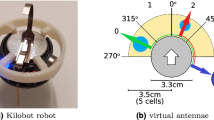Abstract
In this article we specify an individual-based foraging swarm (i.e., group of agents) model with individuals that move in an n-dimensional multi-obstacle environment. The motion of each individual (i) is determined by three factors: i) attraction to the local object position (\(\bar x_{io + } \)) which is decided by the local information about the individuals’ position that individual i can find; ii) repulsion from the other individuals on short distances; and iii) attraction to the global object position (x goal) or repulsion from the obstacles in the environment. The emergent behavior of the swarm motion is the result of a balance between inter-individual interaction and the simultaneous interactions of the swarm members with their environment. We study the stability properties of the collective behavior of the swarm based on Lyapunov stability theory. The simulations show that the swarm can converge to goal regions and diverge from obstacle regions of the environment while maintaining cohesive.
Similar content being viewed by others
References
Y. Liu, K. M. Passino. Stable social foraging swarms in a noisy environment[J]. IEEE Trans. on Automatic Control, 2004, 49(1): 30–44.
V. Gazi, K. M. Passino. Stability analysis of swarms[J]. IEEE Trans. on Automatic Control, 2003, 48(4): 692–697.
C. M. Breder. Equations descriptive of fish schools and other animal aggregations[J]. Ecology, 1954, 35(3): 361–370.
K. Warburton, J. Lazarus. Tendency-distance models of social cohesion in animal groups[J]. J. of Theoretical Biology, 1991, 150(4): 473–488.
A. Okubo. Dynamical aspects of animal grouping: swarms, schools, flocks, and herds[J]. Advances in Biophysics, 1986, 22(1): 1–94.
A. Jadbabaie, J. Lin, A. S. Morse. Coordination of groups of mobile autonomous agents using nearest neighbor rules[J]. IEEE Trans. on Automatic Control, 2003, 48(6): 988–1001.
V. Gazi, K. M. Passino. Stability analysis of social foraging swarms[J]. IEEE Trans. on Systems, Man, and Cybernetics, Part B: Cybernetics, 2004, 34(1): 539–556.
S. Chen, H. Fang. Modeling and stability analysis of large-scale swarm[J]. Control and Decision, 2005, 20(5): 490–494
S. Liu, F. Yang. Evaluation of minimum circumscribed circle form error by computational geometry approach[J]. J. of Engineering Graphics, 2000, 21(3): 83–89.
S. Chen, H. Fang. Optimal path planning for dynamic environment[J]. J. of Huazhong University of Science & Technology (Nature Science Edition), 2003, 31(12): 29–31.
Author information
Authors and Affiliations
Additional information
This work was supported by the National Natural Science Foundation of China (No. 60574088).
Shiming CHEN received the Ph.D. degree in Control Theory and Control Engineering from Huazhong University of Science and Technology in 2006. His current research interests include multi-agent system, swarm intelligence.
Huajing FANG received the Ph.D. degree in Control Theory and Control Engineering from the Huazhong University of Science and Technology in 1991. He is working with the Department of Control Science and Engineering, Huazhong University of Science and Technology, where he is a professor, the director of the Institute of Control Theory, the associate director of the Center for Nonlinear and Complex Systems. His current research interests include networked control system, control system fault diagnosis, robust fault-tolerant control and swarm systems.
Rights and permissions
About this article
Cite this article
Chen, S., Fang, H. Modeling and stability analysis of social foraging swarms in multi-obstacle environment. J. Control Theory Appl. 4, 343–348 (2006). https://doi.org/10.1007/s11768-006-5170-8
Received:
Revised:
Issue Date:
DOI: https://doi.org/10.1007/s11768-006-5170-8




